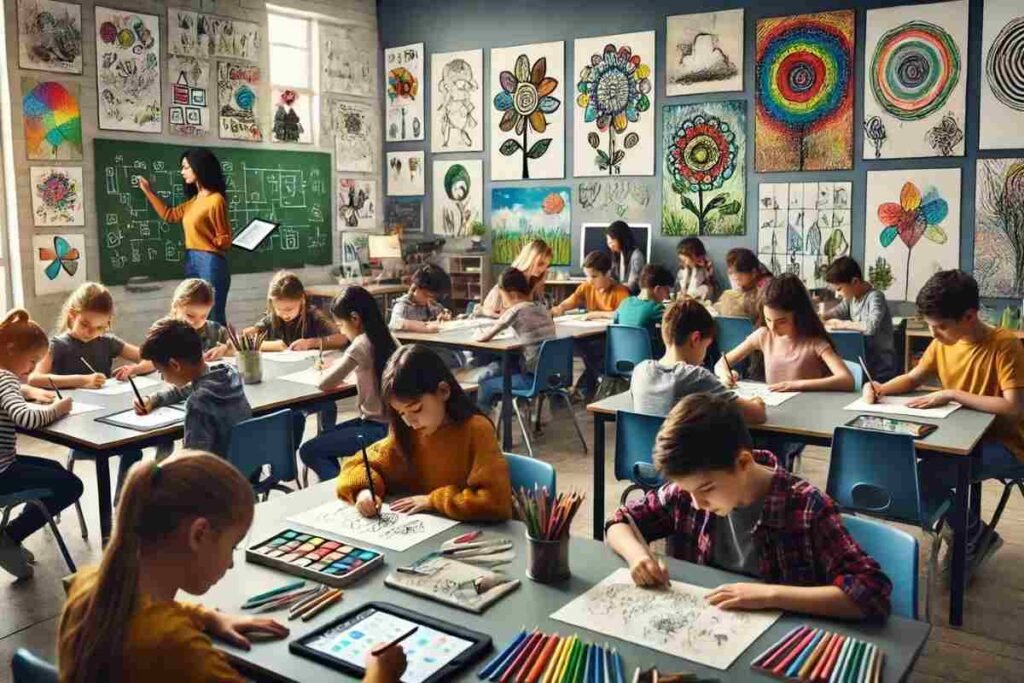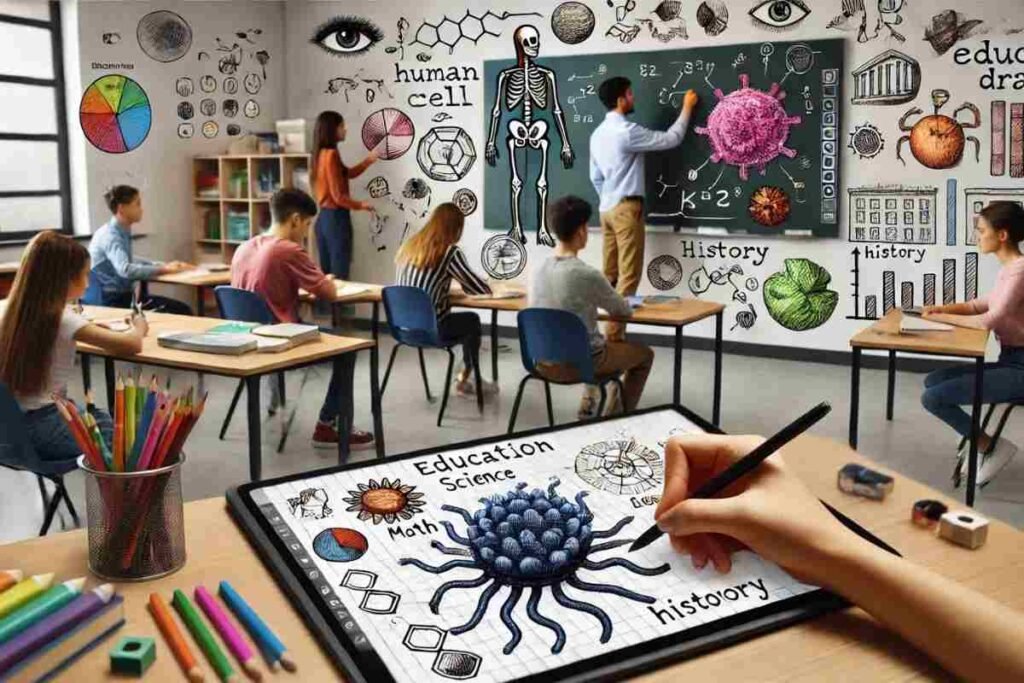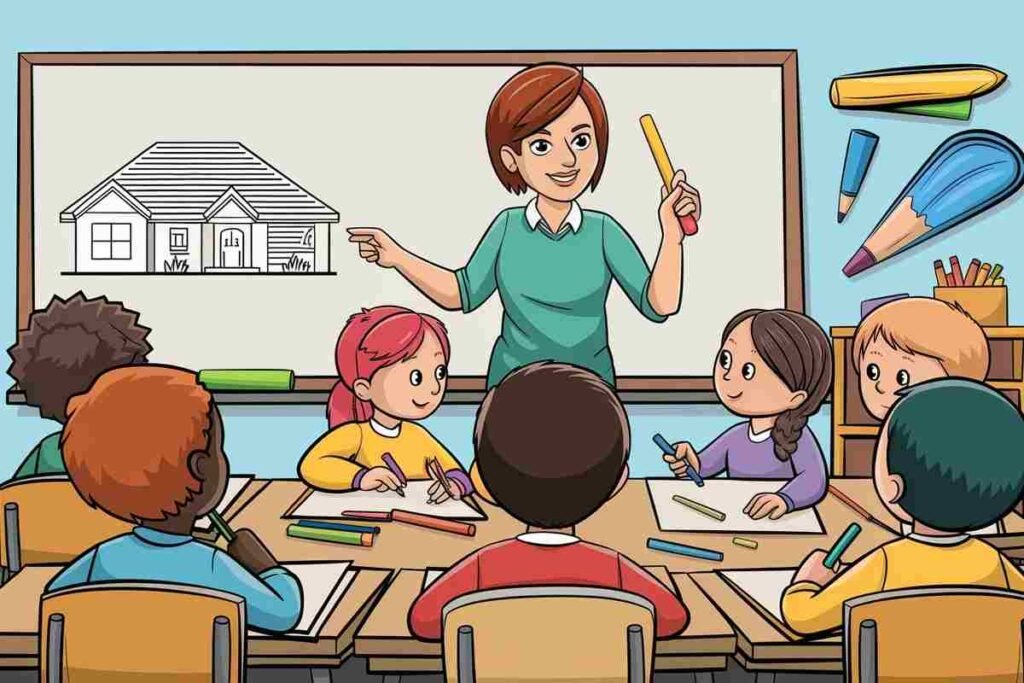Incorporating Education Drawing into the classroom goes beyond artistic expression. It’s a powerful educational tool that supports cognitive growth, fine motor skills, creativity, emotional well-being, and more.
Educators can foster a richer, more engaging learning environment by integrating drawing activities across various subjects and using both traditional and digital tools.
This comprehensive guide explores the many facets of education drawing, its benefits, and practical steps for seamless integration into the curriculum.
Benefits of Education Drawing

Education drawing offers several core benefits that can significantly enhance students’ learning experiences:
Enhancing Cognitive Development
- Visual Learning and Memory: Drawing encourages active engagement and better retention, as students process information in ways that improve recall. Through education drawing, they gain critical thinking skills by organizing thoughts and visualizing complex ideas.
- Conceptual Understanding: Students often find it easier to understand abstract ideas when they visualize them. For example, drawing shapes, patterns, or relationships helps clarify concepts in subjects like math and science, making complex ideas more approachable.
Improving Motor Skills
- Fine Motor Skills and Coordination: Education drawing strengthens fine motor skills essential for writing, drawing, and other precise tasks. The act of holding a pencil, making controlled movements, and managing pressure enhances hand-eye coordination, which is foundational for academic and everyday tasks.
- Early Development Benefits: For young learners, improving motor skills through drawing builds a critical foundation for later academic success. It helps them achieve better control over their movements, which translates to improved handwriting and precision in other subjects.
Fostering Creativity and Innovation
- Creative Thinking: Education drawing encourages students to experiment, think outside the box, and express themselves in unique ways. By fostering creativity, educators help students develop essential problem-solving skills, an asset across academic and personal settings.
- Skill Development for the Future: Creativity is a highly valued skill in the 21st century. Incorporating drawing into education helps students cultivate an innovative mindset and prepares them for future challenges.
Enhancing Emotional Expression and Well-Being
- Emotional Outlet: Drawing serves as a non-verbal medium for students to communicate their thoughts and feelings, especially valuable for those who struggle with verbal expression. Through drawing, children can process their emotions and improve their emotional health.
- Building Confidence: Offering students a safe, judgment-free environment to draw and express themselves builds self-confidence and encourages them to be comfortable with their unique perspectives.
Supporting Inclusive and Special Education
- Therapeutic Benefits: Drawing is widely used in special education and therapeutic settings as it allows students to communicate and express themselves comfortably. Art therapy can reduce anxiety, boost confidence, and help manage emotions.
- Accessible Learning for All: Education drawing can be a more accessible means of communication for students with learning differences or disabilities, offering an alternative to traditional text-based learning.
| Benefit of Education Drawing | Description |
|---|---|
| Cognitive Development | Improves memory, visualization, and critical thinking. |
| Motor Skills | Enhances fine motor skills essential for handwriting and coordination. |
| Creativity | Develops problem-solving skills and a creative mindset. |
| Emotional Expression | Provides a non-verbal outlet for feelings, improving emotional well-being. |
| Inclusive Education | Makes learning accessible for students with special needs through visual communication. |
How Education Drawing Enhances Different Subjects

Education Drawing in Science
- Diagramming and Visualization: Students learn complex scientific concepts through diagrams of cells, life cycles, and human anatomy. Education drawing in science helps break down challenging material into visual elements, making it easier to understand and retain.
Education Drawing in Mathematics
- Geometry and Spatial Awareness: Drawing shapes, angles, and patterns helps students grasp geometry and spatial reasoning. Using visual aids for math concepts such as symmetry, fractions, and ratios fosters better comprehension.
- Graphing and Data Visualization: Encouraging students to draw graphs and data representations enhances their ability to interpret mathematical relationships visually.
Education Drawing in Language Arts
- Storyboarding and Character Development: Storyboarding helps students improve reading comprehension by breaking down narrative elements into visual steps. They can also illustrate characters or events, enriching their understanding of plot and theme.
Education Drawing in History and Geography
- Maps and Timelines: Drawing maps and timelines aids in organizing historical events and geographical knowledge, helping students retain information about important dates, events, and locations.
| Subject | Application of Education Drawing |
|---|---|
| Science | Diagrams of cells, life cycles, anatomy for better understanding. |
| Mathematics | Shapes, graphs, spatial awareness to improve understanding of geometry and ratios. |
| Language Arts | Storyboarding and character illustrations for narrative comprehension. |
| History/Geography | Drawing maps, timelines to visually organize events and locations. |
Tools and Techniques for Integrating Education Drawing

To maximize the benefits of education drawing, leveraging the right tools and resources is essential. Here are ways educators can integrate drawing effectively:
Create a Drawing-Friendly Environment
- Provide Resources: Equip classrooms with pencils, markers, erasers, and sketch paper to encourage spontaneous and structured drawing.
- Dedicated Drawing Spaces: Set up designated areas for drawing activities, allowing students to feel inspired and comfortable.
Use Digital Drawing Tools and Platforms
- Interactive Whiteboards: Digital whiteboards, such as Google Jamboard, enable interactive drawing sessions, allowing both teachers and students to participate.
- Educational Software: Tools like Explain Everything provide collaborative digital drawing spaces, making it easier to create, share, and review drawings as a class.
Encourage Drawing Across Subjects
- Integrate Drawing in Every Subject: Encourage students to use drawing in various subjects, from sketching in science to creating storyboards in language arts. This interdisciplinary approach enriches learning experiences across the board.
Allow Time for Free Drawing
- Unstructured Drawing Sessions: Set aside time for students to draw freely, exploring their interests and experimenting with different techniques. This freedom boosts creativity and helps students develop their own style.
Provide Constructive Feedback
- Emphasize Effort Over Perfection: Constructive feedback focuses on creativity and effort rather than technical skill, building students’ confidence and enthusiasm for drawing.
Showcase Student Artwork
- Display in Classrooms and Hallways: Celebrate students’ work by displaying it around the school. This not only acknowledges their efforts but also inspires other students to participate in drawing activities.
Assessment through Education Drawing
Education drawing can serve as a valuable form of assessment, allowing educators to evaluate understanding through creativity and visualization.
- Mind Maps and Diagrams: Mind maps help assess comprehension by encouraging students to organize information visually.
- Storyboard Creation: In language arts or history, students can create storyboards that summarize lessons or events, providing a tangible reflection of their understanding.
- Illustrated Concepts: In science or math, students can illustrate processes or relationships, showcasing their grasp of the material.
Conclusion
Education Drawing is a transformative approach that brings numerous benefits to students across cognitive, motor, creative, and emotional domains.
By integrating drawing into different subjects, utilizing digital and traditional tools, and creating a supportive classroom environment, educators can unlock students’ potential and foster a love for learning.
With thoughtful application and the right resources, education drawing becomes more than just an artistic outle it becomes a vital educational strategy that equips students with skills they’ll carry throughout life.
This guide offers actionable steps, diverse applications across subjects, and the latest technology, providing a robust framework for educators to harness the full potential of education drawing.
In a world that values creativity, problem-solving, and adaptability, drawing is an invaluable tool in nurturing well-rounded, expressive, and capable learners.
FAQS
What is Education Drawing?
Education Drawing refers to using drawing as a teaching tool to support learning in various subjects, enhancing creativity, understanding, and engagement.
How does Education Drawing help cognitive development?
Drawing aids cognitive growth by helping students visualize concepts, organize thoughts, and improve memory, making abstract ideas easier to grasp.
Can Education Drawing improve motor skills?
Yes, Education Drawing develops fine motor skills, hand-eye coordination, and dexterity, especially in young learners.
Is Education Drawing useful in subjects other than art?
Absolutely! Education Drawing is valuable across subjects like science, math, history, and language arts to illustrate and simplify complex concepts.
What tools are effective for Education Drawing?
Both traditional tools (pencils, markers) and digital tools (tablets, interactive whiteboards) are effective for enhancing learning through drawing.
How does Education Drawing support emotional expression?
Drawing provides a safe outlet for students to express feelings non-verbally, improving emotional well-being and self-confidence.
How can teachers integrate Education Drawing into their curriculum?
Teachers can encourage drawing activities in all subjects, create a drawing-friendly environment, and give constructive feedback to support creativity.
Is Education Drawing beneficial for special education?
Yes, it’s especially helpful in special education, offering a more accessible means for students to communicate and learn visually.